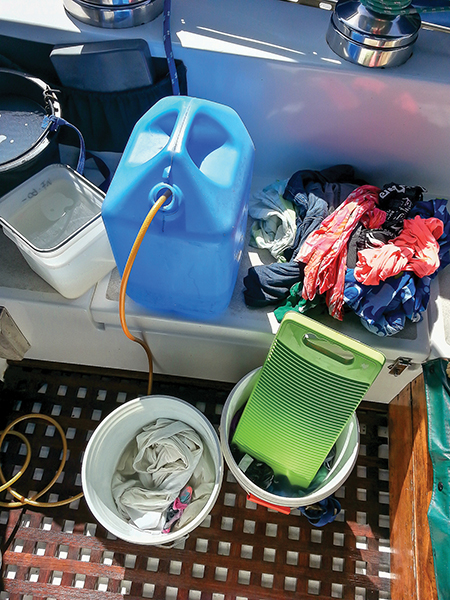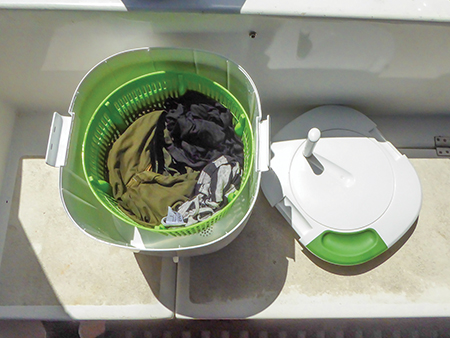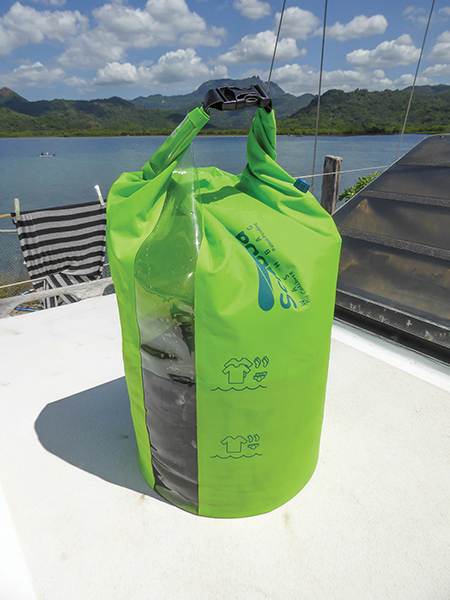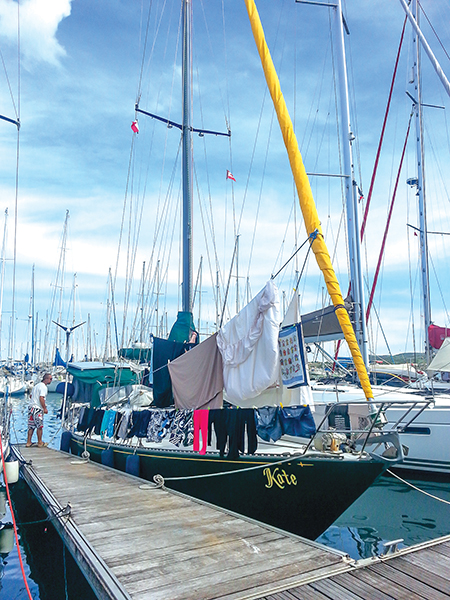The dirt on doing laundry (published April 2018)
When we reached Palau in early 2017 I was giddy with the prospect of dropping off our oversized bag of dirty clothes at a laundromat. It wasn’t because we had just finished a rough 3-week passage and the hamper was overflowing, or that our laundry was a little more malodorous than usual. It wasn’t even because I couldn’t be bothered doing the washing myself, I didn’t have that option at the Fluff and Fold. It was simply because it was the first time in over two years that our clothes would be washed in a proper washing machine, with hot water.
Our recent sailing route had taken us through the outer islands of Vanuatu, the Solomons and Papua New Guinea, where most people did not have power and rain catchment was the main source of water. There was little opportunity to take our laundry ashore, and no need to tax local resources when there was.
Honestly, I don’t mind doing the laundry. We have a watermaker on board that can easily keep up with our weekly cockpit laundry parties, and the methodical rhythmic hand washing can be quite calming. I have always found the sight of clothes hanging on the lines, flapping in a gentle breeze rather romantic, and there is a certain satisfaction of slipping on a clean shirt after a refreshing shower or climbing into crisp, sea-breeze-fresh sheets at the end of the day. But after two years of imposed scrubbing, I was starting to feel like I had been put through the wringer.
LAUNDRY TODAY or NAKED TOMORROW
Keeping the crew clean has been a concern for as long as human kind has been navigating. From Captain Cook, who was famous for his strict hygiene standards and made his crew wash their clothes and air their bodies on a regular basis to NASA, where the first astronauts were not only required to stay in their flight suits most of the mission but weren’t even issued a second pair of undies. We have understood that keeping clean is not only good for your body it is important for crew morale.
Our clothing absorbs up to 80 percent of the oil, sweat and other fluids that our bodies secretes everyday. Add to that the constant shedding of skin and hair and by the end of the day you are wearing a delightful cocktail of dirt, whether you can smell it or not. Wear an article of clothing for several days without washing it and the fabric will reach a saturation point, no longer able to absorb anything that is rubbed on it.
With nowhere to go, all the sweat and oils produced by your body will simply stay on your skin. Not only will you be the “stinky sailor” you will probably find you experience skin irritation, rashes or even boils. If this isn’t reason to break out the elbow grease and do a bit of laundry I don’t know what is.
OUT, OUT DAMN SPOT
 The best, and most efficient, way to do laundry on board has been debated and discussed for decades. Many sailors subscribe to the wash-in-salt-water, rinse-in-fresh-water method, after all it works in the galley. On the surface it sounds like you will be saving on water by using sea water to do the bulk of the work during the wash cycle. However, it takes twice as much fresh water to rinse the salt free of your clothes than it would if you just use fresh water judiciously to wash in the first place. Failing to rinse all the salt out of your laundry will leave you feeling damp and clammy and promote mold growing on items that are left in storage.
The best, and most efficient, way to do laundry on board has been debated and discussed for decades. Many sailors subscribe to the wash-in-salt-water, rinse-in-fresh-water method, after all it works in the galley. On the surface it sounds like you will be saving on water by using sea water to do the bulk of the work during the wash cycle. However, it takes twice as much fresh water to rinse the salt free of your clothes than it would if you just use fresh water judiciously to wash in the first place. Failing to rinse all the salt out of your laundry will leave you feeling damp and clammy and promote mold growing on items that are left in storage.
Some sailors wait for a downpour to fill the dinghy to the gunnels and then use it as a giant wash basin. This is a great idea, but you must make sure your dinghy is free of salt or else doing a rain dance will be in vain.
Then there is the old trick of washing your clothes in ammonia. The reasoning here is you’ll not only save water during the wash cycle but there is also no need to rinse your clothes; the ammonia will simply evaporate, apparently leaving you with clean, scent-free laundry.
Although ammonia is used in several household products it is classified as a caustic and hazardous chemical. It is highly irritating to your skin, eyes and respiratory tract and when mixed with bleach, a common additive to the white load, it will produce a poisonous gas. Ammonia is also toxic to fish; it is believed to be responsible for occasional large die offs in the aquaculture industry. Using ammonia on board to wash your clothes is potentially harmful to both you and the environment, not even worth consideration in my view.
If you can’t schlep it ashore to a community water source or drop it off at the laundromat there are no two ways about it; doing laundry on board is a laborious task that demands a large quantity of fresh water.
 IT’LL ALL COME OUT IN THE WASH
IT’LL ALL COME OUT IN THE WASH
For years I had a popular compact, hand-crank washing machine on board and although I found it handy I always felt the design was problematic. Its plastic stand was a little too delicate to withstand the weight of a full load of wet clothes and rigors of the tumble action. It did a fine job cleaning clothes, and it was fairly water efficient, but after several jury rigs the frame eventually broke beyond repair.
It was back to the trusty, old five-gallon bucket. Many people use a toilet plunger or even buy a special made plunger-like wand, but I prefer to get my feet wet and agitate the laundry like I am making wine. Not only does stomping save my back, it gives me a bit of a cardio workout too. Using a bucket, it is easy to measure and monitor how much water is used, however it is still a lot of work to get the clothes machine-like clean. Recently I came across a couple of small, manual washers that looked like they might just make laundry day a little easier.
The Laundry POD is a manual spin-type design, but instead of a tumble motion it uses a perforated basket that spins inside a drum, much like a salad spinner. Like my old hand-cranked machine the Laundry POD is a bit bulky, measuring about 15″ square, which meant finding a place to store it onboard was a bit difficult. However, the overall design is streamline; the drain hose and handle fold away so that there is nothing to get caught while squeezing it into the cupboard.
Performance-wise it did the job, but not without a few hiccups. The salad spinner design is easy to use and efficient, but it produced lots of suds, especially when using a liquid detergent. This meant an extra rinse cycle and using more water. Although the unit agitated the basket well I found the clothes didn’t shift around very much, so it is still necessary to spot scrub by hand if items are heavily soiled. Where the Laundry POD really works is during the spin cycle. Taking advantage of centrifugal forces and a well-designed drainage system clothes spun in the Laundry POD are line ready and dry quickly, and less time hanging on the lines the better.
 At the same time, I tested the Scrubba; a small but innovative washing bag. Essentially a 10 litre roll-top waterproof bag the designers of the Scrubba have added a window, a burp valve and a textured washboard surface inside. What it lacks in volume it certainly makes up for when it comes time to put it away. Folding down to a tidy package not much bigger than the average smartphone means you can afford to carry a few on board. Designed with travellers in mind the Scrubba can only wash an item or two at a time, obviously too small to handle a week worth of boat laundry. However, it won me over the first time I tried it and I have been using it regularly since.
At the same time, I tested the Scrubba; a small but innovative washing bag. Essentially a 10 litre roll-top waterproof bag the designers of the Scrubba have added a window, a burp valve and a textured washboard surface inside. What it lacks in volume it certainly makes up for when it comes time to put it away. Folding down to a tidy package not much bigger than the average smartphone means you can afford to carry a few on board. Designed with travellers in mind the Scrubba can only wash an item or two at a time, obviously too small to handle a week worth of boat laundry. However, it won me over the first time I tried it and I have been using it regularly since.
Simple to use and water efficient this wash bag has become my go-to method for laundering delicates. With no moving parts and nowhere to get strings or straps caught the Scrubba cleans up when it comes to board shorts, bras and bikinis. It is also perfect for knits and fabrics like silk that can’t be handled roughly. I think this would come in very handy for sailing families; children are an endless source of laundry and their pint-sized wardrobe would be a perfect fit in the Scrubba.
SO FRESH & SO CLEAN
Doing laundry isn’t all about clean clothes, it should also be about clean living. Knowing that our waste water goes directly overboard, I feel obligated to think of the environmental impact of the detergents I choose to use.
As a habit I have always avoided using fabric softeners. I find the residue that they leave on the fabric and their heavy scents leave me feeling itchy. Adding vinegar or baking soda to your rinse water will give you that fabric-soften feel without all the chemicals. Remember clothes don’t have to smell Spring Fresh to be clean.
Harsh chemicals, fragrances and additives like optical brighteners are not only highly irritating to the skin they are toxic to the environment. It is not always possible but when it is available I stock up on laundry soap that is made of plant-based ingredients and free of dyes, parabens, phosphates and sulphates. These detergents might cost a few extra pennies a load, but keeping the planet keep clean is worth the investment.
They say that the most memorable days end with the dirtiest clothes. So, next time you are standing over a pile of smelly laundry don’t forget all the fun times you had making the mess.
* Items were sent to Blue Water Sailing for testing, however all opinions are those of the author.
Heather Francis is from Nova Scotia, Canada and has worked on boats throughout the world. For the last decade she has doing laundry on board Kate, a Newport 41’, she and her Aussie partner, Steve, bought in California. They are currently in the Philippines looking for wind and are planning to do a lap around the planet, albeit slowly. You can follow their adventures at www.yachtkate.com.
LAUNDRY TIPS
Adding too much soap to your wash load can be just as bad as adding too little, resulting in clothes that are less than clean. Be sure to read the directions. • Choosing modern, quick dry fabrics can cut down on your water consumption and wash time. I love the new microfibre towels, keeps us dry and never smells like a wet dog! • Drying laundry inside out will prevent fading and will make sure things like pockets dry thoroughly. • Keep in mind that liquid soaps dissolve better than powders in cold water, except those designed for cold water washing.















